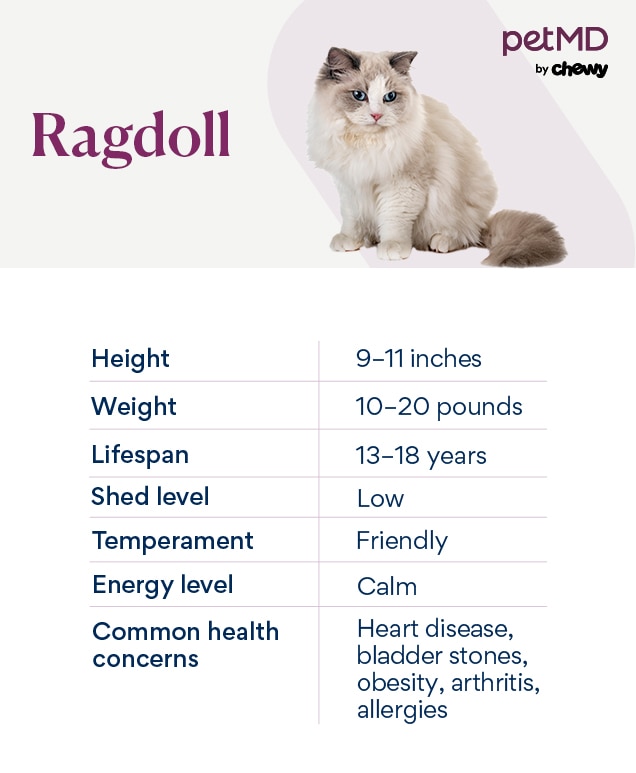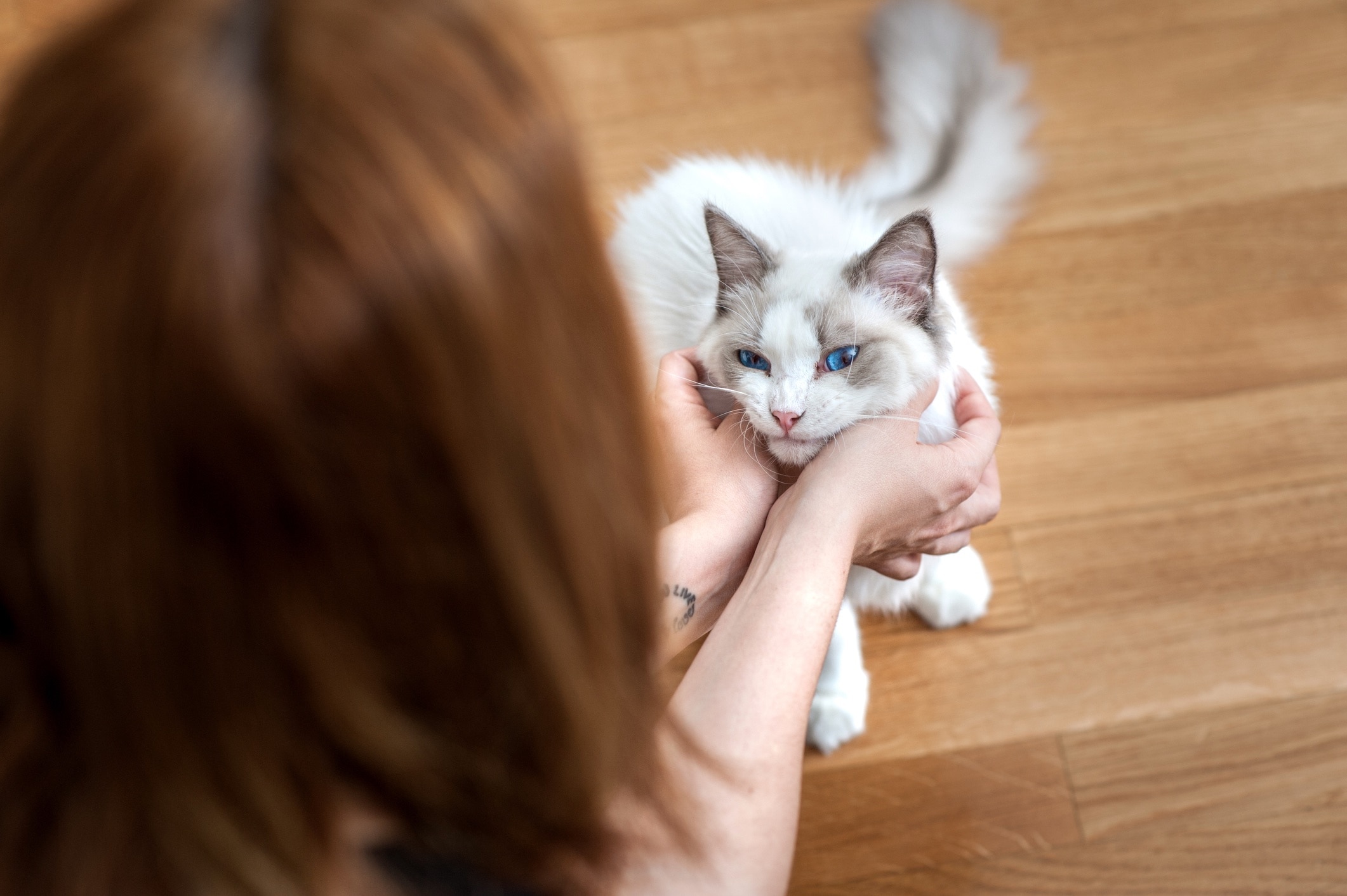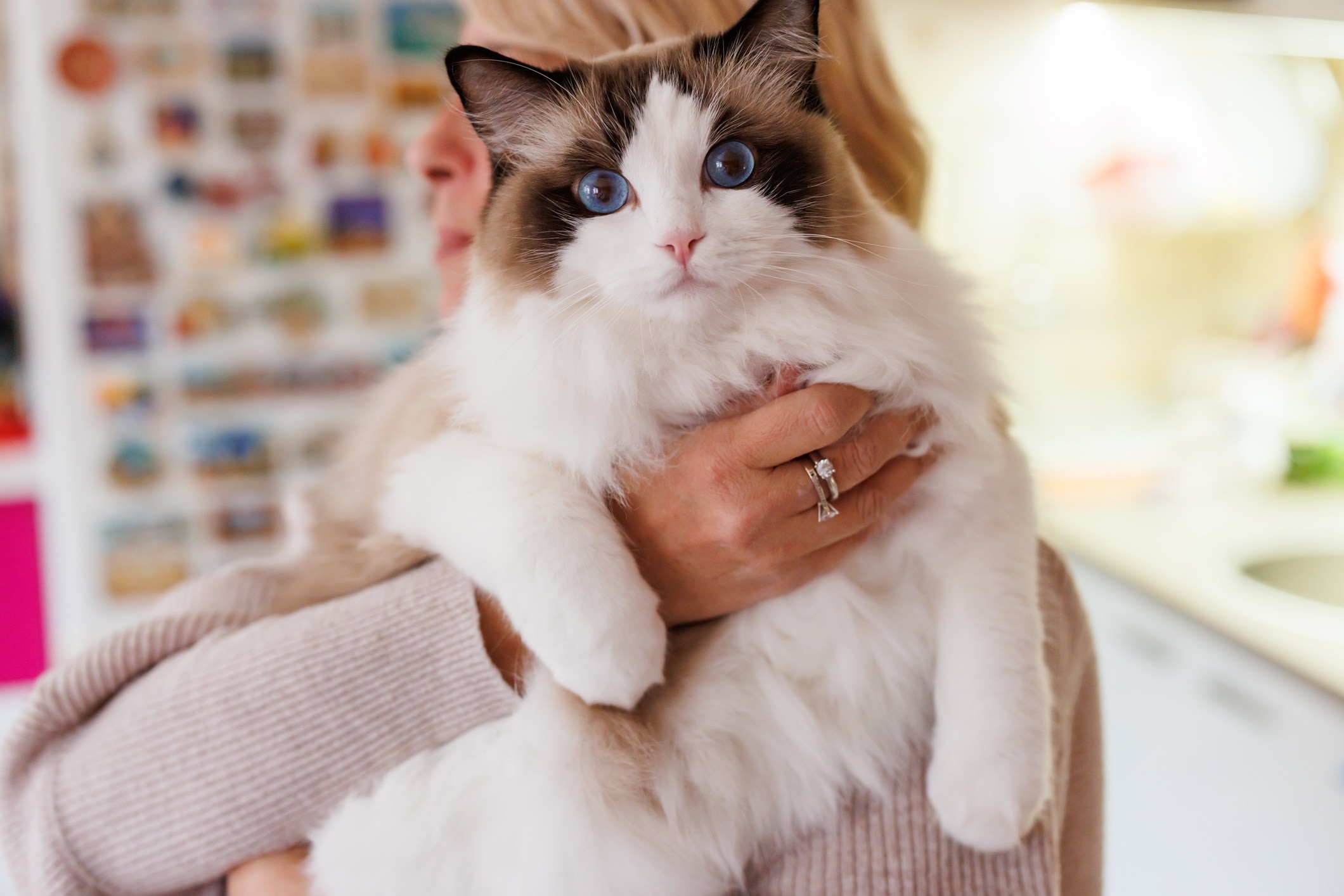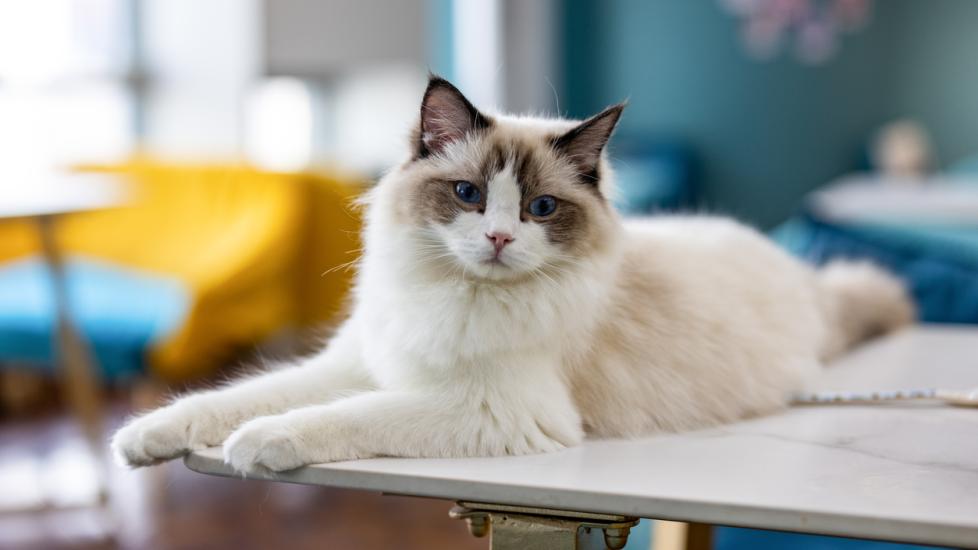Ragdoll
The Ragdoll’s name comes from a behavior they’re well-known for: relaxing to the point of floppiness when being petted, cuddled, or held. This friendly, blue-eyed cat can grow to be 20 pounds and sports a soft, medium-length coat in several colors and patterns.
Because Ragdolls are so laid-back, they tend to do well in a variety of households with all kinds of two- and four-legged family members—as long as they get plenty of attention.
Caring for a Ragdoll Cat

The Ragdoll cat has a number of traits many people might associate with dogs, says Amy Stadter, TICA Ragdoll Breed Committee chairperson. A licensed cat judge, Stadter has cared for Ragdolls since 1997, and began breeding and showing them the next year. “They are uniquely friendly, social, and affectionate,” she says. “They are one of the most laid-back, most adaptable breeds and are typically very well-suited to all types of living situations.”
Ragdolls do enjoy some interactive playtime with their people, though, and it’s important that pet parents be prepared to groom that medium-to-long coat. Some Ragdolls only need to be combed (more effective than brushing) once or twice a week, but others have a heavier undercoat that requires more attention.
Shop for Your Breed
Ragdoll Cat Health Issues
The Ragdoll is a healthy cat in general, says Iram Sharma, DVM, an Ohio-based veterinarian and veterinary writer. The breed has a typical feline lifespan of up to 17 years. However, there are a few potential health issues to be aware of.
Heart Disease
Sharma says the hereditary condition hypertrophic cardiomyopathy (HCM) lurks within the Ragdoll breed. “It is a health condition where the cat's heart muscle becomes too thick, making it harder to pump blood effectively,” she says. However, there is a DNA test for the Ragdoll that has helped breeders eliminate the most common cause of HCM in the breed. While it’s still possible for Ragdolls to have this condition, it’s become uncommon.
If you notice your cat being more lethargic, eating less, experiencing difficulty breathing, or being unable to exercise, take her to the vet. A number of medications can be used to treat HCM, and your vet will likely recommend a sodium-restricted diet going forward.
Bladder Stones
Bladder stones are painful and can be serious, or even life-threatening, if they lead to a complete urinary blockage. Signs of bladder stones include:
-
Peeing more frequently (but in small amounts)
-
Straining to urinate
-
Crying out while peeing
-
Other pain-related changes in behavior
A urinalysis, bloodwork, and imaging (like X-rays) will help your veterinarian diagnose this issue. Treatment can vary, and male cats are at higher risk for a urinary blockage. A prescription diet may help the stones dissolve enough to pass within two to four weeks, but if not, surgery may be required.
A prescription diet is the most common strategy for managing this issue, although increasing water intake (including through canned food) can also help. For male cats that have recurring issues despite a diet change, a surgical procedure called a perineal urethrostomy, which widens the urethra, can be done.
Weight and Joint Issues
Like other large cat breeds, Ragdolls are prone to gaining excess weight, and obesity is no laughing matter. Because they’re big kitties to begin with, extra pounds can really do a number on their joints, leading to arthritis and mobility problems, especially as they age.
Measuring your cat’s food, and keeping an eye on their weight and body composition, is the best way to prevent this. As your Ragdoll gets closer to their senior years, talk to your veterinarian about pain management for arthritis.
Food and Seasonal Allergies
Stadter says Ragdolls can be more sensitive to food and seasonal allergens than some other breeds. Keep an eye on their coat, skin, and bathroom habits, and talk to your vet if your cat seems itchy, or if you notice changes in her skin or coat.
What To Feed a Ragdoll Cat

The most important thing in choosing the best cat food is to ensure it provides the nutrition your kitty needs and meets all necessary regulations. Selecting a food approved by the Association of American Feed Control Officials (AAFCO) is a smart way to do this. Many experts also recommend feeding Ragdolls wet food to help them stay hydrated, as canned food contains more water than kibble.
However, Sharma says wet food comes with a catch. “No matter the breed, all cats are prone to dental problems, and Ragdolls are no exception,” she says. “In contrast to dry food that mechanically scrapes off plaque, wet food simply glides through their mouth, which causes the accumulation of tartar.”
Additionally, wet food tends to be higher in protein and fat with a lower percentage of carbohydrates, which can lead to your cat becoming hungrier more quickly and gaining weight. Therefore, Sharma generally recommends pet parents feed their cat a mix of dry and wet food.
How To Feed a Ragdoll
Because Ragdolls can be hearty eaters and are prone to weight gain, measure an appropriate amount of life stage-appropriate food (kitten, adult, or senior) for your cat at each meal. And yes, treats count toward their daily caloric intake!
How Much Should You Feed a Ragdoll?
Starting with the recommended measurement on the label of your cat food is best; from there, keep tabs on your Ragdoll’s body composition—keeping in mind that their fluffy coats can make them appear larger—to see whether you need to adjust the amount.
If you have questions about whether your cat is an appropriate weight or how much to feed her, your vet is a fantastic resource.
Nutritional Tips for Ragdolls
Ragdolls can be more prone to food allergies than other breeds, says Stadter. That makes it especially important to be aware of what food you’re feeding your cat, so if you need to talk to your vet about potential allergies, you know what kitty’s been eating.
Behavior and Training Tips for Ragdoll Cats
Ragdoll Personality and Temperament

The Ragdoll’s famously friendly nature has been known to make fans out of folks who never considered themselves cat people, says Stadter. A docile breed that generally loves a good snuggle session, Ragdolls are not as high-energy as some cats, but they do like to play, especially when their humans get in on the game.
“We like to say they have their ‘crazy 15 minutes’ once or twice a day,” Stadter says. They’re rarely overly vocal, unless they’re hungry or in need of a little extra affection, in which case they’ll make little noises to get your attention.
This breed is generally great with people and pets alike—in fact, Stadter says they prefer to live in a home with other Ragdolls or pets, especially if it’s a home where people are gone during the day. This is even more true when Ragdoll kittens are socialized properly from the start. Not every Ragdoll loves to be carried around or sit on laps, but they definitely want to be in the middle of whatever the family is doing.
Ragdoll Behavior
Typically, this friendly and social breed is a breeze to live with, so long as they get the time and affection they require from their people. “A lonely Ragdoll is an unhappy Ragdoll,” Stadter says, “and may develop bad or annoying habits out of frustration.”
Ragdoll Training
As cats go, Ragdolls are quite trainable, Stadter says. “Most Ragdolls can be motivated by the right treats or toys,” she says. “I have had more than one pet parent clicker-train their Ragdoll.” In fact, she’s used clicker training to teach one of her own Ragdolls to do agility.
Fun Activities for Ragdoll Cats
-
Lap time
-
Cuddling
-
Climbing into boxes
-
Clicker training
Ragdoll Grooming Guide
With a coat that’s described as medium-length or semi-long, the Ragdoll is a beautiful cat in any of the official Ragdoll colors (seal, blue, chocolate, lilac, red, and cream) and patterns (mitted, van, bicolor, and colorpoint). But that gorgeous coat does need upkeep to stay healthy.
Skin Care
Ragdolls don’t typically require special skin care, but pet parents need to be aware of changes in their cat’s coat. This can indicate that their Ragdoll has allergies.
Coat Care
Stadter recommends Ragdoll parents have two good metal combs at the ready: a larger one and a smaller, finer one. “If you have a couple good combs and you comb your Ragdoll once or twice a week—possibly every couple days during spring shedding—you shouldn’t have problems with matts,” she says.
She also suggests starting—and keeping—a grooming routine from kittenhood. “Ragdolls that regularly experience grooming such as nail trimming, bathing, and/or ear cleaning from kitten age on generally tolerate it well,” Stadter says.
If you don’t keep up on regular grooming and your cat’s only experience is having her matts combed out (which is painful!), you’re inadvertently teaching her that grooming is something to fear.
Eye Care
The Ragdoll’s big blue eyes don’t typically require regular upkeep. If you notice changes in your cat’s eyes, such as redness or discharge, contact your vet.
Ear Care
Cat parents need to know the signs of an ear infection, which include head shaking, scratching of the ears, and discharge. If you note any of these symptoms, contact your veterinarian to have your Ragdoll examined.
Considerations for Pet Parents

Because they’re so easygoing, Ragdolls are a great choice for all kinds of families, including those with children or other pets—although it’s always recommended that introductions between cats and children, or other pets, be made slowly and under supervision. Children must also be taught to play gently.
Ragdoll cats are true social butterflies, so they do best in a home where they get plenty of regular interaction. They want to be part of the family, so be prepared to bring them into whatever you’re doing!
Ragdoll Cat FAQs
Are Ragdoll cats hypoallergenic?
No, Ragdolls are not considered to be hypoallergenic cats. Although they aren’t heavy shedders, Ragdolls have longer fur, require regular grooming, and shed seasonally. Plus, some Ragdolls have a thicker undercoat than others, which can lead to additional shedding.
How much are Ragdoll cats?
Stadter says you should expect to pay $1,800–$2,500 for a cat from a reputable breeder.
“Because they have quickly become one of the most popular breeds, it’s important to do your homework and buy from the right breeder,” she says. “If you invest the time to find the right reputable breeder, you are much more likely to be happy with the temperament and socialization of your kitten.”
Do Ragdoll cats make good house cats?
Absolutely! In fact, this breed must live inside with you, says Stadter. “Ragdolls need to be indoor-only cats, unless they have access to a safe, fully enclosed catio or yard,” she says. “They are social and friendly, and not street-smart enough to be wary of potential dangers.”
Featured Image: iStock/somethingway
